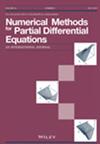用不连续Galerkin方法求解非线性对流扩散方程的时空标量辅助变量法
IF 1.7
3区 数学
Q1 MATHEMATICS, APPLIED
引用次数: 0
摘要
本文章由计算机程序翻译,如有差异,请以英文原文为准。
Spatio‐temporal scalar auxiliary variable approach for the nonlinear convection–diffusion equation with discontinuous Galerkin method
In this paper, a scalar auxiliary variable approach combining with a discontinuous Galerkin method is proposed to handle the gradient‐type nonlinear term. The nonlinear convection–diffusion equation is used as the model. The proposed equivalent system can effectively handle the nonlinear convection term by incorporating the spatial and temporal information, globally. With the introduced auxiliary variable, the stability of the system can be simply characterized. In the space, according to the regularity of the system, an optimal accuracy is obtained with the discontinuous Galerkin method. Two different time discretization techniques, that is, backward Euler and linearly extrapolated Crank–Nicolson schemes, are separately considered with first order and second order accuracy. The proposed schemes are unconditionally stable with proper selected parameters. For the error estimates, the optimal convergence rates are rigorously proved. In the numerical experiments, the convergence information is confirmed and a benchmark problem with shock tendency is then followed with robustness demonstration.
求助全文
通过发布文献求助,成功后即可免费获取论文全文。
去求助
来源期刊
CiteScore
7.20
自引率
2.60%
发文量
81
审稿时长
9 months
期刊介绍:
An international journal that aims to cover research into the development and analysis of new methods for the numerical solution of partial differential equations, it is intended that it be readily readable by and directed to a broad spectrum of researchers into numerical methods for partial differential equations throughout science and engineering. The numerical methods and techniques themselves are emphasized rather than the specific applications. The Journal seeks to be interdisciplinary, while retaining the common thread of applied numerical analysis.

 求助内容:
求助内容: 应助结果提醒方式:
应助结果提醒方式:


